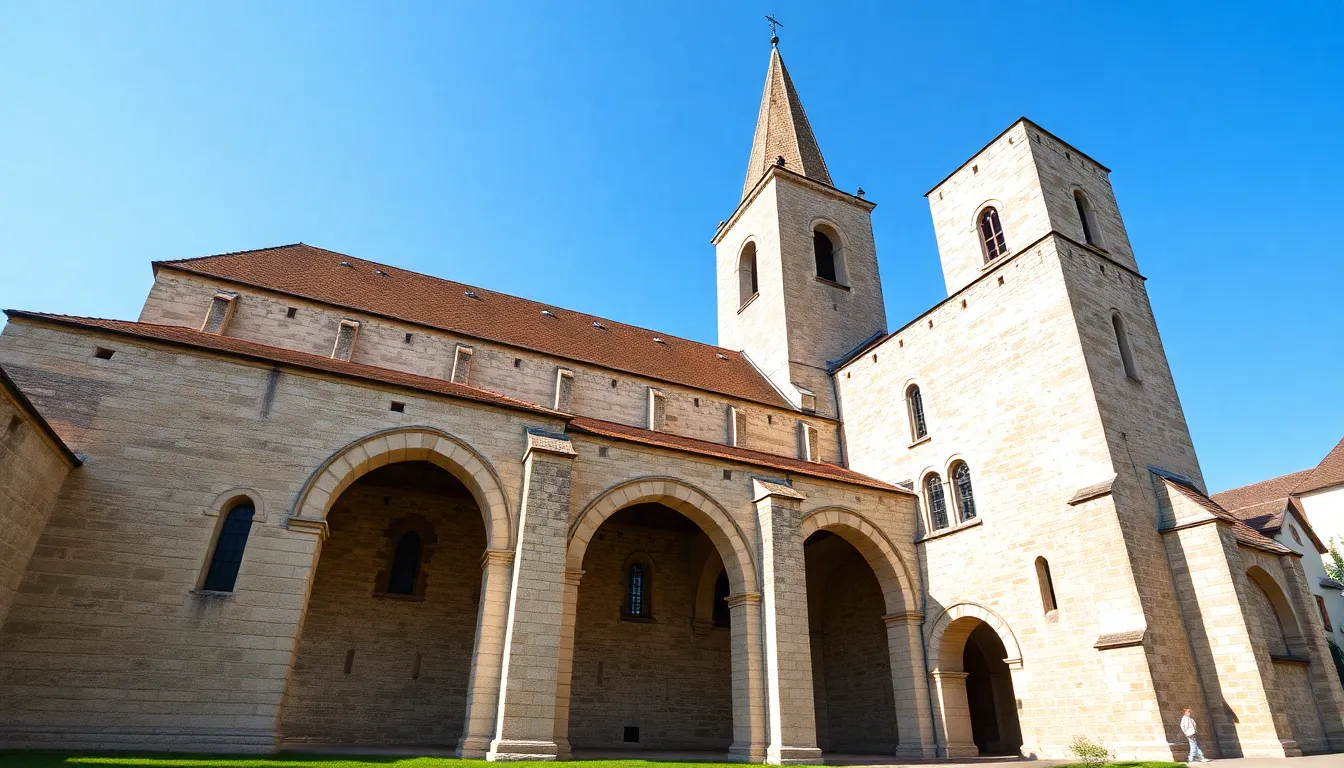Switzerland might be famous for its chocolate and cheese, but its architecture deserves a standing ovation too. Imagine a place where medieval castles hug the mountains and modern marvels flirt with the skyline. This isn’t just a postcard; it’s a visual feast that’ll make any architecture lover weak in the knees.
Table of Contents
ToggleOverview of Switzerland Architecture
Switzerland’s architecture showcases diverse styles reflecting its rich cultural heritage. Medieval castles often dominate the landscape, standing proudly against the backdrop of majestic mountains. These structures, such as Chillon Castle and the Old City of Bern, illustrate the country’s historical significance and architectural prowess.
Contemporary buildings contribute significantly to the architectural narrative. Zurich’s Prime Tower and the Fondation Beyeler in Riehen exemplify modern design that harmonizes with nature. Innovative architects integrate sustainable practices, creating spaces with minimal environmental impact.
Swiss architecture features various styles, ranging from Gothic to Baroque and modernism. Renowned architects like Le Corbusier and Peter Zumthor have gained international acclaim. Their designs often blend functionality with artistic expression, enriching the architectural dialogue.
Emphasis on local materials plays a crucial role in Swiss architecture. Rocky landscapes inspire many structures, fostering a harmonious relationship between buildings and their surroundings. While creating innovative designs, architects prioritize sustainability and energy efficiency.
Cultural influences contribute to the rich tapestry of Switzerland’s built environment. Influences from neighboring countries can be seen in various architectural elements. Regions such as Ticino exhibit Italian characteristics, while French-speaking areas reflect a more design-oriented aesthetic.
Overall, Switzerland’s architecture combines historical depth with modern innovation. Architectural marvels, characterized by striking forms and functional designs, serve as a testament to the nation’s commitment to preserving its heritage while embracing contemporary trends. Exploring Switzerland’s architectural landscape offers a unique perspective on its identity and cultural richness.
Historical Influences

Switzerland’s architectural landscape reflects centuries of historical evolution, showcasing various styles that symbolize the nation’s cultural journey.
Romanesque Architecture
Romanesque architecture prominently features in Switzerland’s historical monuments. Characterized by rounded arches, thick walls, and small windows, this style flourished between the 9th and 12th centuries. The Abbey of St. Gall stands as a prime example, illustrating the intricate design and structural innovation of the time. Numerous churches exhibit similar elements, showcasing the craftsmanship of medieval builders. Preservation of these structures highlights Switzerland’s commitment to conserving its architectural heritage. This period laid the foundation for further developments, influencing future architectural styles.
Gothic Architecture
The Gothic architecture movement significantly impacted Switzerland from the 12th to the 16th century. Notable for its pointed arches, ribbed vaults, and flying buttresses, Gothic structures allowed for taller and more luminous buildings. Examples include the majestic Cathedral of Bern and the breathtaking Cathedral of Lausanne, both demonstrating intricate facades and detailed sculptures. Cultural exchanges with France catalyzed the adoption of Gothic elements in Swiss design. Emphasis on verticality and light transformed the architectural landscape, deepening the nation’s historical narrative. Overall, the Gothic period marked a critical advancement, setting the stage for Switzerland’s architectural evolution.
Modern Architecture Trends
Switzerland’s architectural scene thrives on modern trends that blend innovation with sustainability. New materials and techniques drive these designs forward while respecting the environment.
Influential Swiss Architects
Renowned architects like Peter Zumthor play a pivotal role in contemporary design. Zumthor’s works, including the Therme Vals, emphasize the relationship between nature and human experience. Another influential figure, Herzog & de Meuron, consistently pushes boundaries with projects like the Tate Modern in London. Their ability to merge functionality with beauty sets a benchmark in modern architecture. Additionally, many emerging architects prioritize sustainability, ensuring new buildings minimize their ecological footprint.
Iconic Modern Structures
Prominent modern structures define Switzerland’s skyline. The Prime Tower in Zurich stands at 126 meters, offering breathtaking views and innovative design elements. Another notable example, the Vitra Fire Station by Zaha Hadid, showcases bold lines and a futuristic aesthetic. In Basel, the Fondation Beyeler integrates art with architecture, using natural light to enhance the visitor experience. Each of these structures embodies a different aspect of modern architectural philosophy while promoting a dialogue between form and function.
Sustainable Architecture in Switzerland
Sustainable architecture plays a vital role in Switzerland’s building practices, showcasing innovative methods that reduce environmental impact. Architects prioritize energy efficiency, utilizing locally sourced materials in designs that respect the natural landscape. Flood-proof construction becomes essential in certain areas, with buildings incorporating sustainable drainage systems to manage rainfall.
Energy-efficient materials, such as wood and stone, contribute to reduced carbon footprints. Green roofs and solar panels frequently adorn structures, allowing them to blend seamlessly with the environment while promoting renewable energy use. Adaptive reuse of existing buildings also receives attention, as it minimizes waste and preserves historical significance.
Iconic examples of sustainable architecture include the Vitra Campus, where structures respect both form and function through eco-friendly designs. The Novartis Campus exemplifies biodiversity with green spaces that enhance urban living while supporting local ecosystems. Projects like these reflect a commitment to harmonizing modern architecture with sustainability principles.
Passivehaus design principles earn recognition for reducing energy consumption in residential buildings. These approaches result in homes that maintain comfortable temperatures year-round without excessive energy use. Regulations further support these sustainable practices, with Swiss building codes often mandating environmentally-friendly construction standards.
Collaborative efforts among architects, urban planners, and local authorities foster sustainable development in cities like Zurich and Geneva. Green building certifications, such as Minergie, promote energy-efficient practices and encourage eco-conscious choices among builders. The Swiss public’s awareness of sustainability contributes to growing demand for green architecture, reinforcing its presence in urban and rural settings.
Projects demonstrating responsible design principles illustrate Switzerland’s forward-thinking approach, showcasing how architecture can positively impact the environment. By valuing sustainability, Switzerland exemplifies how modern buildings can coexist with nature, setting a precedent for the future of architectural practices globally.
The Role of Tradition in Contemporary Design
Tradition plays a crucial role in shaping contemporary architecture in Switzerland. Influences from historical styles inform modern designs, creating a dialogue between the past and present. Architects often draw inspiration from local materials and construction techniques, ensuring new structures resonate with their heritage.
Gothic and Romanesque elements frequently appear in contemporary buildings, reflecting a commitment to preserving cultural identity. For instance, the pointed arches of Gothic architecture may inspire modernist facades, while thick walls echo Romanesque strength. This blend of styles fosters a cohesive architectural narrative throughout the country.
Urban planners prioritize harmony with surroundings when integrating traditional aspects into new designs. Community-oriented spaces often incorporate historical motifs, contributing to a sense of place. The use of regional stone and timber in construction reinforces connections to local landscapes.
Examples include the Fondation Beyeler, which harmoniously combines modernist principles with traditional Swiss characteristics. The building’s relationship with nature mirrors the care taken by architects like Peter Zumthor, known for respecting historical contexts while pushing design boundaries. The Vitra Fire Station by Zaha Hadid exemplifies this approach, as its innovative form pays homage to local architectural language.
Tradition also enhances sustainability in Swiss architecture. Utilizing indigenous materials supports eco-friendly practices, while preserving craftsmanship and cultural heritage. Architects focus on minimal environmental impact by integrating energy-efficient designs, exemplified through several recent projects like those at the Novartis Campus.
Resilience in modern Swiss architecture is evident through the careful consideration of historical influences. Each new building honors the rich architectural legacy while addressing contemporary needs, ensuring a vibrant future for Switzerland’s urban landscapes.
Switzerland’s architectural landscape is a stunning blend of history and innovation. The juxtaposition of medieval castles with modern marvels creates a unique visual narrative that captivates visitors and locals alike. This commitment to sustainability and cultural heritage ensures that Switzerland remains at the forefront of architectural excellence.
As architects continue to draw inspiration from the past while embracing contemporary design principles, the country’s buildings reflect a harmonious relationship with nature. The future of Swiss architecture promises to uphold its rich legacy while adapting to the needs of a changing world. This dynamic interplay between tradition and modernity will undoubtedly inspire generations to come.





